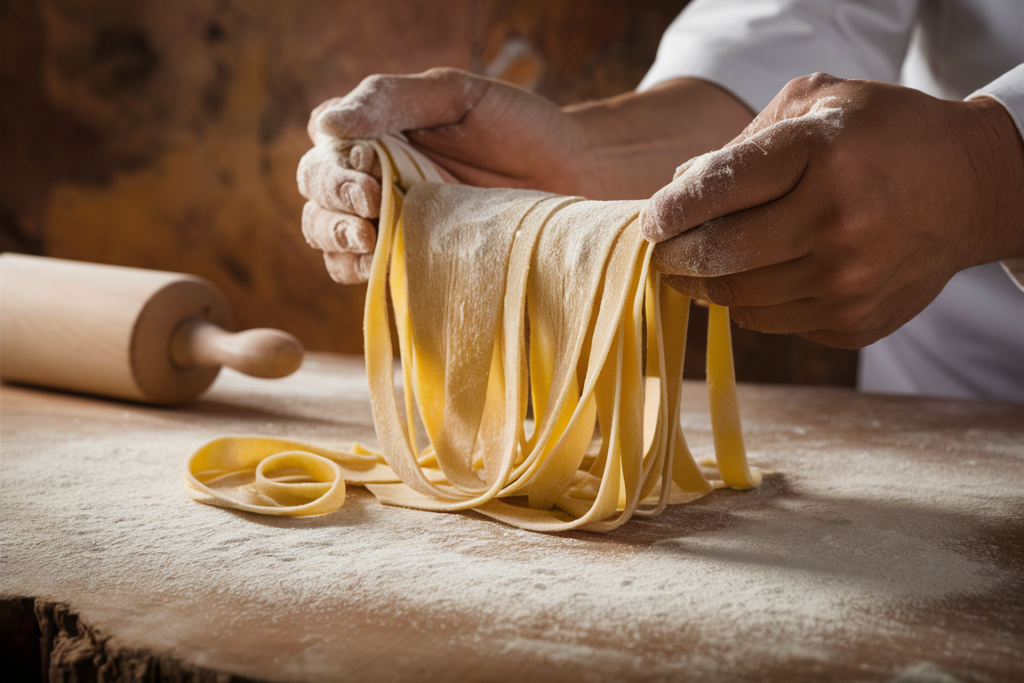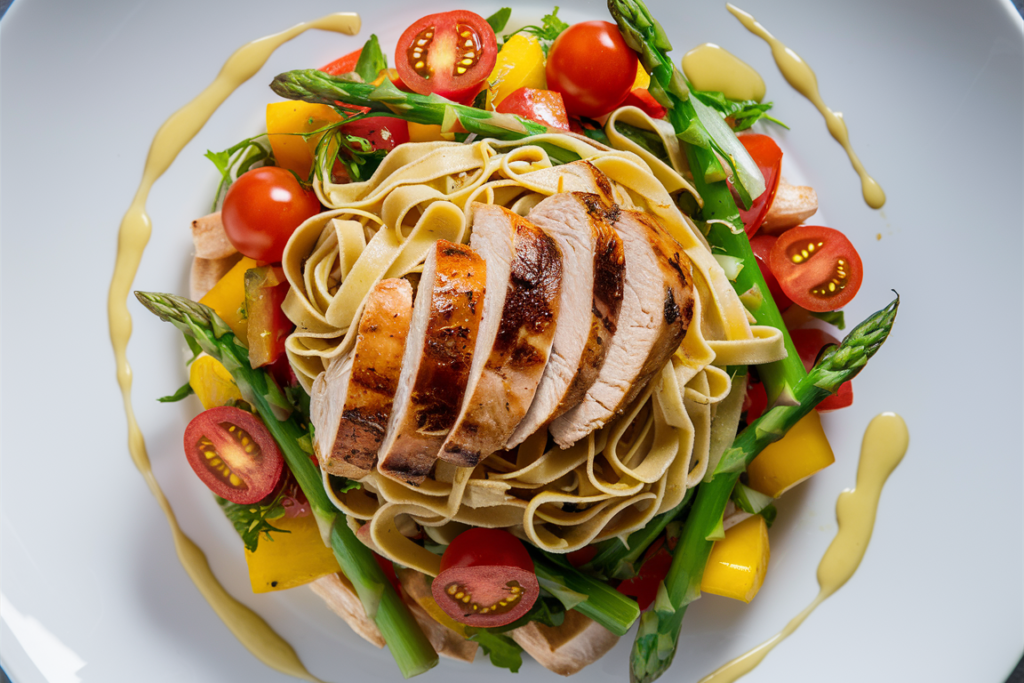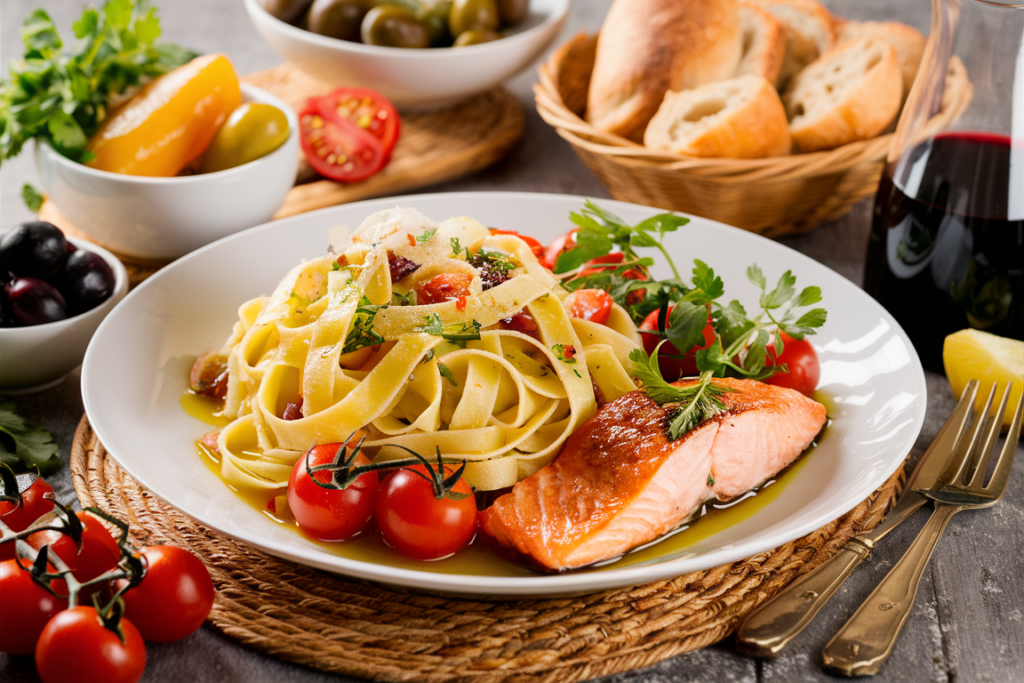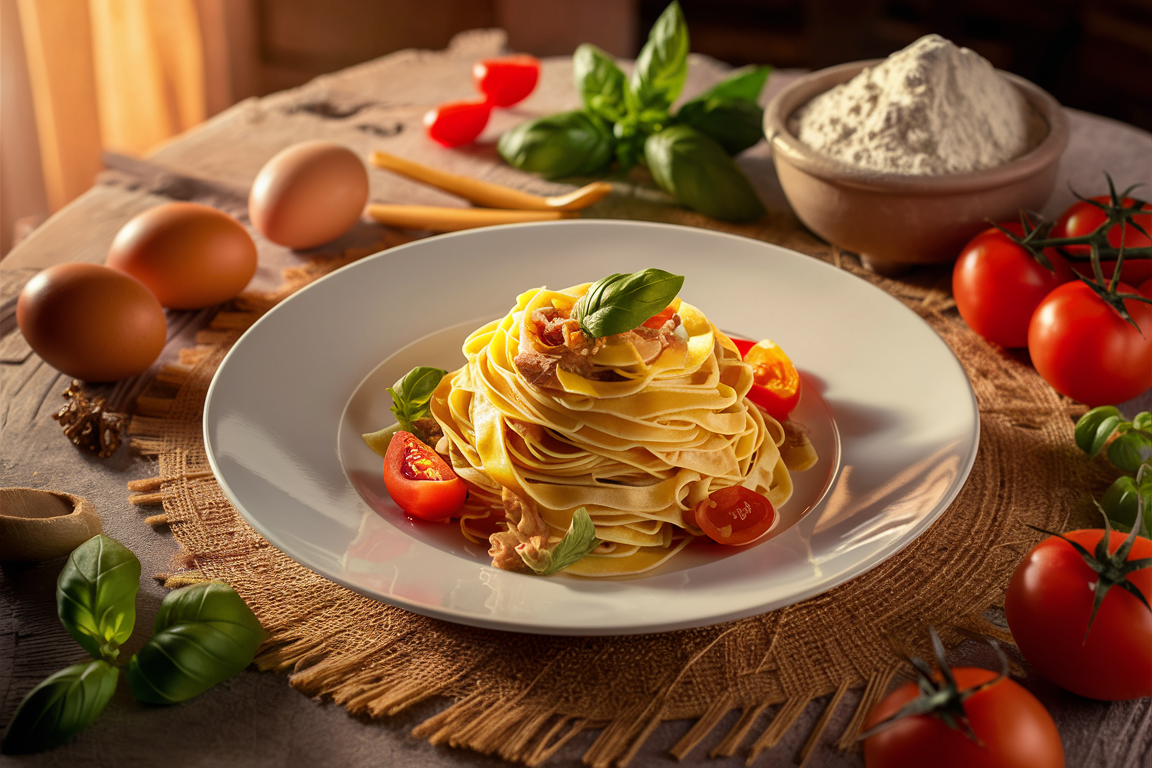Part 1: Understanding Tagliatelle
What Makes This Italian Pasta Unique?
This traditional Italian dish is celebrated for its long, flat ribbons, slightly wider than fettuccine. Originating in the Emilia-Romagna and Marche regions, it is a versatile type of pasta that pairs wonderfully with a variety of sauces. From hearty meat-based ragù to lighter, vegetable-inspired dressings, its shape is designed to hold sauces perfectly, delivering a flavorful balance in every bite.

Tracing the History of This Iconic Dish
this traditional Italian dish has deep roots in Italian culinary history, often linked to the Renaissance period. Legend attributes its creation to a 15th-century chef who crafted the pasta to mimic the flowing locks of Lucrezia Borgia on her wedding day. While this story may be apocryphal, it highlights the cultural importance of tagliatelle in Italian heritage. Historically, it was prepared as a luxurious dish for special occasions, reflecting Italy’s rich culinary traditions.
Traditional Ingredients Behind the Ribbon Pasta
Tagliatelle is traditionally made with just two main ingredients:
- Eggs: Provide richness, structure, and a golden hue.
- Flour: Typically 00 flour, known for its fine texture, is used for a silky smooth dough.
These simple yet high-quality ingredients are combined to create a tender yet firm pasta perfect for pairing with hearty sauces.
Fresh vs. Dried Pasta – What’s the Difference?
this traditional Italian dish can be prepared in two main forms:
- Fresh : Made from scratch, it offers a delicate, tender texture. Best consumed immediately after preparation.
- Dried : Easier to store and often slightly firmer in texture, ideal for those looking for convenience.
The choice between fresh and dried often depends on the dish and the desired texture.
Nutritional Profile
Exploring Healthier Options in Pasta
Whole-wheat tagliatelle contains higher levels of fiber and nutrients, including B vitamins and magnesium, making it a healthier choice compared to regular white tagliatelle. However, white boasts a softer texture and more traditional flavor.
Calories in a Serving – What to Know
On average, one serving (100 grams) of cooked this traditional Italian dish provides approximately:
- Regular : 300-350 calories
- Whole-Wheat : Slightly lower calorie content due to increased fiber content.
Common Uses of this traditional Italian dish in Cuisine
Tagliatelle is an iconic base for Italian dishes such as:
- Al Ragù (Bolognese): A rich meat sauce that clings perfectly to the pasta’s wide ribbons.
- With Truffle Butter: A luxurious dish highlighting the pasta’s subtle flavor.
- Seafood : Featuring prawns, mussels, and a touch of garlic for a Mediterranean twist.
How Tagliatelle Fits Into Different Diets
Creative Alternatives for Gluten-Free Diets
While traditional tagliatelle is made with wheat, gluten-free versions are increasingly available, crafted from rice, corn, or lentil flours. These alternatives provide similar texture and taste while catering to those with gluten sensitivities or celiac disease.
Part 2: Health Aspects of Tagliatelle
Is This Traditional Pasta Healthy?
Like many forms of pasta, offers both nutritional benefits and potential drawbacks, depending on how it’s prepared and consumed. When made with high-quality ingredients and paired with nutrient-rich toppings, it can be part of a balanced diet. However, excessive portions or calorie-heavy sauces may tip the scale toward unhealthy.
The key is moderation and making mindful choices, such as opting for whole-wheat varieties or pairing it with lean proteins and vegetables.

The Role of Carbohydrates in a Healthy Diet
Carbohydrates, the primary macronutrient in this traditional Italian dish, are essential for energy. They are especially important for athletes or individuals with active lifestyles. However, not all carbs are created equal. Refined carbs, such as those in traditional white tagliatelle, can cause spikes in blood sugar, while whole-grain alternatives provide a slower, more sustained energy release.
Key takeaways about carbohydrates:
- Energy Source: Carbs are the body’s preferred fuel.
- Fiber Matters: Whole-wheat tagliatelle adds fiber, aiding digestion and improving satiety.
- Portion Control: Eating pasta in moderation is critical to reaping its benefits.
Tagliatelle’s Contribution to Daily Nutritional Needs
This traditional Italian dish provides important nutrients, though the profile can vary based on the type:
- Regular : Rich in simple carbohydrates, offering quick energy but limited fiber.
- Whole-Wheat : Contains essential nutrients like magnesium, iron, and B vitamins.
- Egg-Based : Offers additional protein, enhancing its nutritional value.
Including this traditional Italian dish in a meal can complement other nutrient sources, such as lean proteins and healthy fats.
Impact of Portion Sizes on Health
The healthiness ofthis traditional Italian dish often depends on portion sizes. A typical serving size is 100 grams cooked, but many dishes exceed this, contributing to calorie overconsumption.
Benefits of managing portion sizes:
- Maintains energy balance.
- Prevents excessive carb intake.
- Leaves room for nutrient-dense toppings, such as vegetables and lean proteins.
Benefits of Homemade
Making tagliatelle at home offers several advantages:
- Control Over Ingredients: Choose whole-grain flours or add spinach for color and nutrition.
- Freshness: Homemade pasta retains a delicate texture and superior taste.
- Customization: Adjust egg quantities to align with dietary needs.
Making pasta at home not only enhances the dish but also opens up opportunities to experiment with healthier ingredients and variations.
Potential Drawbacks of Regular Tagliatelle Consumption
While delicious, this traditional Italian dish can pose certain health challenges:
- High Glycemic Index: Regular tagliatelle can lead to quick blood sugar spikes.
- Low Fiber Content: Standard pasta lacks the fiber necessary for optimal digestion.
- Calorie Density: When paired with creamy sauces, the calorie count can skyrocket.
Being aware of these potential drawbacks encourages healthier preparation and consumption habits.
How to Make this traditional Italian dish Healthier
Boosting the nutritional profile of this pasta dish requires thoughtful ingredient selection and careful preparation techniques:
- Opt for whole-wheat pasta or gluten-free options.
- Add nutrient-dense toppings, such as grilled chicken, shrimp, or roasted vegetables.
- Use olive oil-based sauces instead of heavy cream or cheese-based sauces.
Adding Nutrient-Dense Ingredients
Here are a few examples of nutrient-packed ingredients to elevate your dish:
- Vegetables: Spinach, zucchini, or cherry tomatoes.
- Lean Proteins: Grilled chicken, turkey, or legumes.
- Healthy Fats: Olive oil, avocado, or nuts.
Combining these elements creates a balanced plate, aligning with various dietary needs.
Whole-Wheat Tagliatelle vs. Refined Flour Tagliatelle
Switching to whole-wheat tagliatelle offers the following health advantages:
- Higher fiber content, aiding digestion and enhancing fullness.
- Lower glycemic index, leading to more stable energy levels.
- Increased nutrient density, including magnesium, zinc, and B vitamins.
Despite these benefits, refined tagliatelle can still fit into a balanced diet when consumed in moderation.
The Impact of Sauces and Toppings on this traditional Italian dish
The choice of sauce and toppings significantly influences the overall healthiness of a tagliatelle dish. For example:
- Tomato-Based Sauces: Low in calories, rich in antioxidants like lycopene.
- Creamy Sauces: High in saturated fats and calories, best enjoyed occasionally.
- Pesto or Olive Oil: Provides healthy fats and enhances flavor without overwhelming the dish.
For a lighter option, try mixing flat ribbon pasta with olive oil, garlic, and steamed vegetables.
Part 3: Integrating Tagliatelle Into a Balanced Diet
this traditional Italian dish can be a delicious and satisfying component of a balanced meal plan when consumed in moderation. Integrating it thoughtfully ensures you enjoy its taste while maintaining nutritional harmony. Consider these tips:
- Portion Control: Stick to recommended serving sizes (100 grams cooked).
- Pair with Protein: Add chicken, tofu, or fish for a balanced meal.
- Incorporate Vegetables: Boost fiber and vitamins with steamed or roasted veggies.
- Choose Lighter Sauces: Opt for olive oil, tomato-based, or broth sauces to reduce calorie density.

Balancing this traditional Italian dish this way aligns with many diets, such as the Mediterranean diet, known for its heart-healthy benefits.
Tagliatelle in Low-Calorie Meal Plans
Adapting tagliatelle recipes for low-calorie meal plans involves creative substitutions and mindful preparation:
- Use zoodles (zucchini noodles) or spaghetti squash for half of the dish.
- Replace creamy sauces with flavorful but low-calorie alternatives, like garlic-infused olive oil.
- Limit cheese to a sprinkle of Parmesan instead of heavy ricotta or mozzarella.
Low-calorie variations of classic dishes, such as tagliatelle with marinara and basil, allow you to indulge without overindulgence.
High-Protein Tagliatelle Recipes
Tagliatelle pairs beautifully with high-protein ingredients, making it a favorite for those prioritizing protein intake. Here are some examples:
- Tagliatelle with Grilled Chicken and Spinach: A nutrient-packed dish with lean protein.
- Shrimp Tagliatelle in Garlic Butter Sauce: Balances rich flavors with a protein punch.
- Vegan Protein Tagliatelle: Toss with lentil-based pasta, roasted chickpeas, and tahini dressing.
For athletes or active individuals, these meals provide the perfect balance of energy and muscle-repair nutrients.
Low-Carb Alternatives for Tagliatelle Lovers
For those following low-carb diets, alternatives to traditional tagliatelle offer the same enjoyment without the carb load:
- Zucchini Noodles (Zoodles): A fresh and hydrating replacement.
- Shirataki Noodles: Low in calories and carbs, these noodles mimic pasta’s texture.
- Spaghetti Squash: A nutrient-rich, mildly sweet option.
These substitutes ensure that pasta lovers don’t have to compromise on their dietary goals.
Tagliatelle for Athletes and Active Lifestyles
Tagliatelle serves as an excellent carb source for athletes, offering:
- Quick and sustained energy for intense workouts.
- Versatility in pre- or post-workout meals when paired with proteins.
For example, a simple dish of tagliatelle with grilled chicken and a side of sautéed vegetables provides the perfect balance of macronutrients to fuel performance and recovery.
Tagliatelle and Heart Health
In moderation, tagliatelle can be part of a heart-healthy diet:
- Use whole-wheat pasta to incorporate heart-friendly fiber.
- Pair it with healthy fats, such as olive oil or nuts, which support cardiovascular health.
- Avoid heavy cream-based sauces that are high in saturated fats.
A classic Mediterranean-inspired dish, such as tagliatelle with olive oil, garlic, and tomatoes, exemplifies a heart-conscious approach to pasta.
The Role of Olive Oil and Herbs with Tagliatelle
Olive oil and herbs are staples in Italian cuisine, offering both flavor and health benefits. When drizzled over tagliatelle, olive oil provides:
- Antioxidants that reduce inflammation.
- Healthy monounsaturated fats that support heart health.
Enhance the dish with herbs like basil, parsley, or oregano for additional antioxidants and a burst of freshness.
Creating Balanced Plates with Tagliatelle
A balanced plate featuring tagliatelle includes:
- Whole-Wheat Tagliatelle: Base for complex carbs.
- Protein: Grilled salmon, chicken, or plant-based options like tofu.
- Vegetables: Roasted zucchini, bell peppers, or spinach.
- Healthy Fat: Olive oil, nuts, or avocado slices.
This combination ensures you get a mix of macronutrients and micronutrients in every meal.
Understanding the Glycemic Index of Tagliatelle
The glycemic index (GI) of tagliatelle determines how it affects blood sugar levels:
- White Tagliatelle: Higher GI, leading to quicker spikes in blood sugar.
- Whole-Wheat Tagliatelle: Lower GI, resulting in more stable energy levels.
Choosing whole-grain options and pairing them with protein and fat can reduce the overall glycemic impact of your meal.
Is Tagliatelle Suitable for Weight Loss Diets?
Tagliatelle can fit into weight loss diets when prepared thoughtfully:
- Limit portion sizes to avoid excess calories.
- Use whole-wheat pasta to increase satiety.
- Pair with low-calorie, nutrient-rich toppings like vegetables and lean proteins.
Avoid calorie-heavy sauces like Alfredo, opting instead for lighter, tomato-based options.
More FAQs
- Can I freeze tagliatelle? Yes, both fresh and cooked can be frozen for later use.
- What’s the difference between tagliatelle and fettuccine? this traditional Italian dish is slightly wider and originates from a different region of Italy.
- How long does fresh tagliatelle last? Fresh can last 2-3 days in the refrigerator or 1-2 months in the freezer.
- Is tagliatelle gluten-free? Traditional tagliatelle is not, but gluten-free options are available.
- What’s the best sauce for this type of pasta? Popular choices include Bolognese, carbonara, and pesto.
- Can vegans eat tagliatelle? The Traditional contains eggs, but vegan alternatives are available.
- What’s the cooking time for fresh vs. dried tagliatelle? Fresh cooks in 2-3 minutes, while dried takes 8-10 minutes.
- Does whole-wheat tagliatelle taste different? Yes, it has a nuttier flavor and firmer texture compared to white .
- Is tagliatelle suitable for kids? Yes, it’s easy to chew and can be paired with child-friendly sauces.
- What’s a good wine pairing with tagliatelle? White wines like Pinot Grigio pair well with light sauces, while Chianti complements meat-based ragù.

